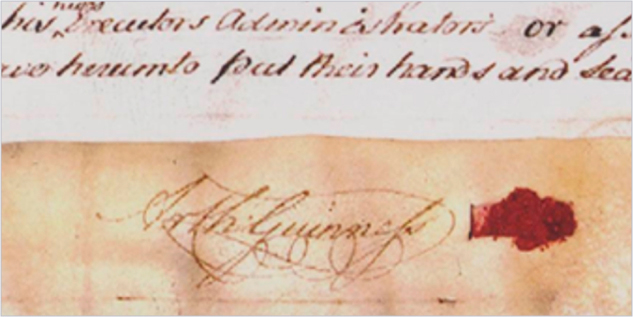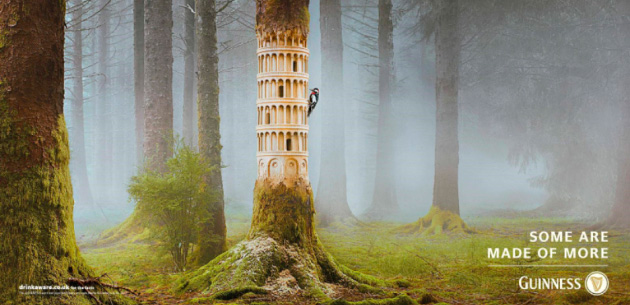A Multi-decade Masterclass in Crafting a
Compelling Brand Narrative

Humans are hardwired to make sense of life through story. Stories help us understand ourselves, define our values and make decisions consistent with those convictions. Brand storytelling leverages the power of effective narratives to connect with audiences in an emotional, values-driven way that centers the customer (rather than the brand) at the heart of the story.
Guinness, one of the world’s largest distributors of stout beer, has been giving a masterclass in brand storytelling for decades. In this article, we’ll extrapolate lessons from the example of Guinness — and explain how you can apply them to your business.
What is Brand Storytelling?

Brand storytelling is a highly effective marketing approach that uses narrative techniques to generate awareness and loyalty, thereby engaging prospects and strengthening relationships with existing customers. The goal is to position your product or service within a larger story that audiences find compelling — something they care about and relate to on an emotional level. To do this, you have to understand your audience.
Guinness knows its target audience well: they’re primarily (but not exclusively) young adults who eschew the hard-partying lifestyle in favor of values like character, integrity and confident self-expression. To connect with these customers, Guinness taps into its own rich history.
The story starts with a signature. In 1759, Arthur Guinness signed a 9,000-year lease on a small, disheveled property and began brewing ale in what would grow to be one of the world’s largest international breweries. Though the brand’s marketing has evolved over time, Guinness’ bootstrapped beginnings as a small business founded by an industrious dreamer continue to supply the narrative context for all its campaigns.
The signature of Arthur Guinness, for example, remains a vital part of the brand’s visual identity — along with its iconic harp and type treatment.

Why is Brand Storytelling
Important?

Contemporary audiences are inundated with advertising content. Whether you’re reading the news, scrolling through social media, streaming TV shows or just driving to work, chances are someone is trying to sell you something. To stand out from the crowd, you have to tell your story in a way that makes the consumer feel seen, as though they are the main character in a larger narrative that explains something important about who they are as a person.
Let’s take a look at how Guinness makes the consumer the protagonist. In its “Empty Chair” commercial (part of the “Made of More” campaign), we see a bartender set a glass of Guinness on an empty table. Day after day, customers come and go, but no one claims the beer — in fact, the bartender actively dissuades pub-goers from sitting at the table or moving its chairs. At the end, we discover the intended recipient of the pint: a military veteran returning from active duty. A voiceover explains, “The choices we make reveal the true nature of our character.”
In this example, the audience is invited to identify with the bartender — a hard-working woman who honors the sacrifice of military personnel through daily acts of gratitude. Why? Because she’s “made of more,” and so is the target audience. This story is compelling because it’s not trying to sell beer; it’s trying to promote a lifestyle, an ethos, a way of being, and to encourage an association between this lifestyle and the brand itself.
When audiences see themselves in your story, they want to participate in it. In this case, consumers participated to the tune of £3.88 per every £1 spent on the “Made of More” campaign. The brand also saw a decrease in price sensitivity and an increase in awareness1.

What are the Elements of a
Strong Brand Narrative?

Crafting a cogent and consistent narrative isn’t as difficult as it seems. By following a few basic principles of effective brand storytelling, you can delight audiences and increase your ROI.
Be Real and Relatable.
Advertising is most powerful when it engages people emotionally. Storytelling invites your customers to connect with your brand on a more personal, human level. It can show them the real people behind the brand, giving them a glimpse behind the curtain to see what makes your business move. This can help build trust and connection. Guinness’ “In Pursuit of More” campaign, for example, takes customers into the original St. James’s Gate Brewery, introducing the people who work behind the scenes to brew their signature Irish stout.
Cultivate Brand Loyalty.
Storytelling can help people connect to your brand by reflecting parts of their personality back to them. When a customer identifies with a brand’s message, they are more likely to feel a sense of brand loyalty. For this to work, it’s important to stay true to your brand’s core identity and make sure to tell your story authentically. In addition to integrity and hard work, Guinness’ “Made of More” campaign celebrates the “confidence to carve [your] own path,” which taps into their brand’s history and resonates with customers who seek adventure.

Emphasize Your Differences.
The way you tell your story can help you stand out from your competitors. What’s different about your approach? What expertise do you bring to the table? What obstacles did you overcome on your journey? Tell your customers — in your own voice. Smart storytelling, which can include personal anecdotes, real-world experiences, earnest explanations or an unexpected approach, can help showcase your business’ personality and make your messaging more memorable. In its 1929 advertisements, Guinness distinguished its voice as strong, sturdy and bold with its now-iconic “Guinness is Good for You” and “Guinness for Strength” campaigns. While Guinness isn’t really good for you and it doesn’t make you stronger, the ads have staying power — just like Guinness’ story.

With a relatable brand story that resonates with your target audience and emphasizes what makes you different, you can strengthen existing relationships and form new partnerships. Ready to captivate customers with authentic storytelling? Let us know. We’re here to help you be bold, go forth and share your story.
Marketing Emails You’ll Actually Want To Read.
Get marketing tips and news sent to your inbox.


